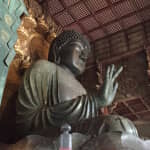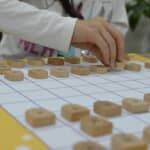Japanese 5 stars 28 March 2017
“Aizu Okiagari-koboshi,” Looking for a Five-star Product of Traditional Japanese Culture
Under the name of “Looking for a Five-star Product of Traditional Japanese Culture,” I-tsu-tsu staff members offer you a report on uncompromising traditional Japanese products dispersed all over Japan.
The first report is about “Aizu Okiagari-koboshi,” a daruma doll made so as to right itself when knocked over. This is a traditional local folk toy of Aizu region, Fukushima Prefecture. We visited “Yamada Mingei Kobo,” only one folk art studio and shop producing genuine handmade Okiagari-koboshi dolls with fastidious traditional production methods in Aizu region.

The origin of “Aizu Okiagari-koboshi” was when a feudal lord of the time made his people make the dolls for sales for the New Year. Therefore, people still purchase the doll for each family member and one extra at the new year market called “Tooka ichi,” the tenth day market, which is held on January 10 annually. People display the dolls on “Kamidana,” a household Shinto altar for the year as a tradition.
I heard that “Yamada Mingei Kobo” is a traditional studio with a history of 400 years. I had an interview with Mr. Yamada. Although I visited there suddenly, he kindly guided me around the studio and gave me easy explanations of each traditional production step.
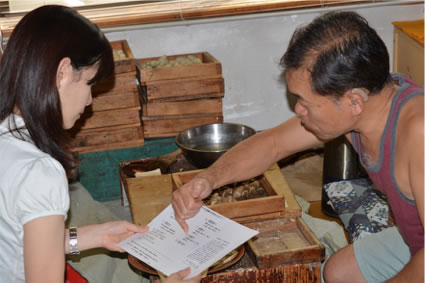
When I visited there, he was working on a process of putting Japanese traditional paper on a wooden model. He worked deftly with traditional technique, and it looked easy. So, I tried it myself. As you can imagine, it was difficult.
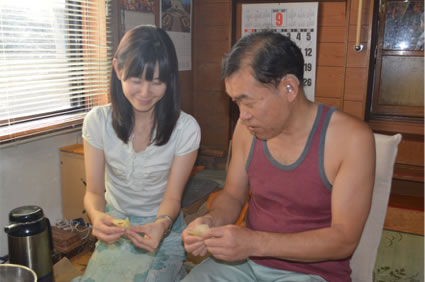
I found a small “Okiagari-koboshi” doll with small eyes in front of me. That doll was made by a machine. Many of the dolls sold at souvenir stores are made by a machine.
I asked him, “Do you draw dolls’ eyes with a brush?”
He replied, “In old days, a brush was luxury. So, people drew eyes on dolls with a bamboo stick cut into small pieces. So, we don’t use a brush.”
That’s why his dolls have rather bigger eyes than the small eyes of machine-made dolls. I sensed tradition even in such a point.
In addition to his uncompromising policy on the handmade method, Mr. Yamada limits the retailers dealing his dolls. The retailers should go along with his policy.
Mr. Yamada is very friendly.
“In the past, I also took a different way. However, we are the only one last studio producing hand-made Okiagari-koboshi.” With this remark, I could sense that he made up his mind to pass on tradition of 400 years at his young age, and it was not easy for him.
His son was also in the shop. Mr. Yamada commented reservedly, “I am happy if he succeeds, but I also understand that he wants to play.” However, his son stated, “I was happy when my father let me draw dolls’ eyes.” I felt his pride in the work and respect toward his father in his remark.
In front of the next generation owner, I experienced traditional painting on the doll.
Students from all over Japan visiting Aizu region for school trip also came this studio.

Okiagari-koboshi is a toy doll which rises each time it falls down just like a proverb “stumbling seven times but recovering eight.” I think that it is a timeless and traditional hope of parents that children rise up and recover each time when they stumble and fall down, and learn something out of the experiences.
Considering that parents of 400 years ago also looked at this Okiagari-koboshi with such a hope, I followed the tradition of Aizu region to purchase a doll for each one of my family and one extra as souvenirs.
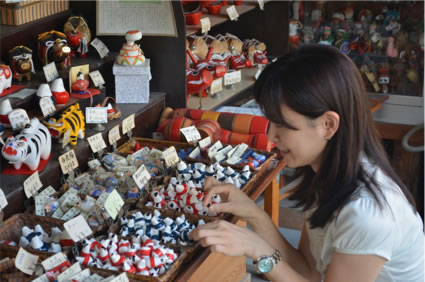
Postscript
Since these dolls are handmade, every single one is slightly different. Their size, balance, and facial expressions are subtly different from each other. It was actually fun to find such a difference when we select one to purchase. I selected six dolls with each one of my family members in my mind. “This doll looks like my eldest daughter.” I thought about such a thing when I purchased the dolls. If every one looks exactly the same, it is less interesting to choose one. These differences express the dolls’ individuality.
In the world of Shogi, each player has “Kifuu,” a playing style of Shogi. Kifu is like a personal character of a player. Some prefer offensive playing style, and others do defensive approach. Players have various different personalities, and their personalities affect their Shogi playing styles.
Kifuu is not only for professional players but is also found in each one of children attending in Shogi classes. I always hope to give good instructions so that every child can demonstrate his/her own Kifuu at the maximum level.
I think that the above is also applicable to parenting. As a mother, I work hard every day for my three children so that they can demonstrate their personalities. I sometimes feel disappointed to find that my children’s interest is different from mine, but I try to accept that as my children’s personality. Looking at the Okiagari-koboshi dolls, I spend my days with spirit of “stumbling seven times but recovering eight.”

Information on “Yamada Mingei Kobo”:
http://www.aizukanko.com/souvenior/8/

